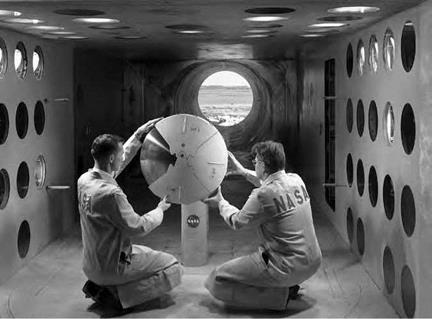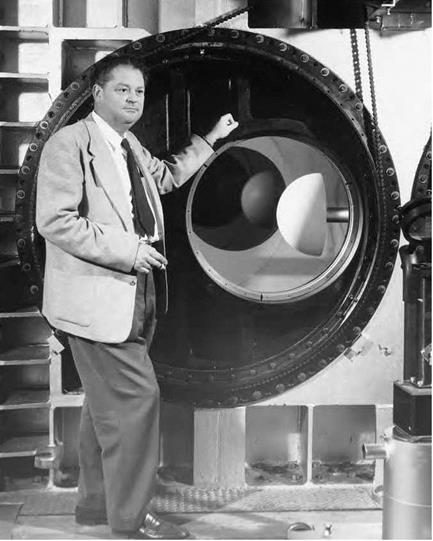Applying Hypersonic Test Facilities to Hypersonic Vehicle Design
One of NASA’s first flight research studies was the X-15 program (1959— 1968). The program investigated flight at five or more times the speed of sound at altitudes reaching the fringes of space. Launched from the wing of NASA’s venerable Boeing B-52 mother ship, the North American X-15 was a true "aerospace” plane, with performance that went well beyond the capabilities of existing aircraft within and beyond the atmosphere. Long, black, rocket-powered, and distinctive with its cruciform tail, the X-15 became the highest-flying airplane in history. In one flight, the X-15 flew to 67 miles (354,200 feet) above the Earth at a speed of Mach 6.7, or 4,534 mph. At those speeds and altitudes, the X-15 pilots, made up of the leading military and civilian aviators, had to wear pressure suits, and many of them earned astronaut’s wings. North American used titanium as the primary structural material and covered it with a new high-temperature nickel alloy called Inconel-X. The X-15 relied upon conventional controls in the atmosphere but used reaction – control jets to maneuver in space. The 199 flights of X-15 program generated important data on high-speed flight and provided valuable lessons for NASA’s space program.
The air traveling over the X-15 at hypersonic speeds generated enough friction and heat that the outside surface of the airplane reached 1,200 °F. A dozen Langley and Ames wind tunnels contributed to the X-15 program. The sole source of aerodynamic data for the X-15 came from tests generated in the pioneering Mach 6.8 11-Inch Hypersonic Tunnel developed by John Becker at Langley in the late 1940s. Fifty percent of the work conducted in the tunnel was for the X-15 program, which focused on aerodynamic heating, stability and control, and load
|
Part of the Project Fire study included the simulation of reentry heating on high-temperature materials in the 9- by 6-Foot Thermal Structures Tunnel. NASA. |
distribution studies. The stability and control investigations contributed to the research airplane’s distinctive cruciform tail. The 7- by 10-Foot High-Speed Wind Tunnel enabled the study of the X-15’s separation from the B-52 at subsonic speeds, a crucial phase in the test flight. At Ames, gun-launched models fired into the free-flight tunnels obtained shadowgraphs of the shock wave patterns between Mach 3.5 and 6, the performance regime for the X-15. The Unitary Plan Supersonic Tunnel generated data on aerodynamic forces and heat transfer. The Lewis Research Center facilities provided additional data on supersonic jet – plumes and rocket-nozzle studies.[595]
There was a concern that wind tunnel tests would not provide correct data for the program. First, the cramped size of the tunnel test sections did not facilitate more accurate full-scale testing. Second, none of NASA’s tunnels was capable of replicating the extreme heat generated by hypersonic flight, which was believed to be a major factor in flying at those speeds. The flights of the X-15 validated the wind tunnel
testing and revealed that lift, drag, and stability values were in agreement with one another at speeds up to Mach 10.[596]
The wind tunnels of NASA continued to reflect the Agency’s flexibility in the development of craft that operated in and out of the Earth’s atmosphere. Specific components evaluated in the 9- by 6-Foot Thermal Structures Tunnel included the X-15 vertical tail, the heat shields for the Centaur launch vehicle and Project Fire entry vehicle, and components of the Hawk, Falcon, Sam-D, and Minuteman missiles. Researchers also subjected humans, equipment, and structures such as the Mercury Spacecraft to the 162-decibel, high-intensity noise at the tunnel exit. As part of Project Fire, in the early 1960s, personnel in the tunnel evaluated the effects of reentry heating on spacecraft materials.[597]
The Air Force’s failed X-20 Dyna-Soar project attempted to develop a winged spacecraft. The X-20 never flew, primarily because of bureaucratic entanglements. NASA researchers H. Julian Allen and Alfred J. Eggers, Jr., working on ballistic missiles, found that a blunt shape made reentry possible.[598] NASA developed a series of "lifting bodies”— capable of reentry and then being controlled in the atmosphere—to test unconventional blunt configurations. The blunt nose and wing-leading edge of the Space Shuttles that are launched into space and then glide to a landing after reentry, starting with Columbia in April 1981, owe their success to the lifting body tests flown by NASA in the 1960s and 1970s.
The knowledge gained in these programs contributed to the Space Shuttle of the 1980s. Analyses of the Shuttle reflected the tradition dating back to the Wright brothers of correlating ground, or wind tunnel, data with flight data. Langley researchers conducted an extended aerodynamic and aerothermodynamic comparison of hypersonic flight- and ground-test results for the program. The research team asserted that the "survival of the vehicle is a tribute to the overall design philosophy, including ground test predictions, and to the designers of the Space Shuttle.”[599]
|
H. Julian Allen used the 8- by 7-foot test section of the NACA Ames Unitary Plan Wind Tunnel during the development of his blunt-body theory. NASA. |
The latest NASA research program, called Hyper-X, investigated hypersonic flight with a new type of aircraft engine, the X-43A scramjet, or supersonic combustion ramjet. The previous flights of the X-15, the lifting bodies, and the Space Shuttle relied upon rocket power for hypersonic propulsion. A conventional air-breathing jet engine, which relies upon the mixture of air and atomized fuel for combustion, can only propel aircraft to speeds approaching Mach 4. A scramjet can operate well
past Mach 5 because the process of combustion takes place at supersonic speeds. Launch-mounted to the front of rocket booster from a B-52 at 40,000 feet, the 12-foot-long, 2,700-pound X-43A first flew in March 2004. During the 11-second flight, the little engine reached Mach 6.8 and demonstrated the first successful operation of a scramjet. In November 2004, a second flight achieved Mach 9.8, the fastest speed ever attained by an air-breathing engine. Much like Frank Whittle and Hans von Ohain’s turbojets and the Wrights’ invention of the airplane, the X-43A offered the promise of a new revolution in aviation, that of high-speed global travel and a cheaper means to access space.
The diminutive X-43A allowed for realistic testing at NASA Langley. First, it was at full-scale for the specific scramjet tests. Moreover, it served as a scale model for the hypersonic engines intended for future aerospace craft. The majority of the testing for the Hyper-X program occurred in the Arc-Heated Scramjet Test Facility, which was the primary Mach 7 scramjet test facility. Introduced in the late 1970s, the Langley facility generated the appropriate flows at 3,500 °F. Additional transonic and supersonic tests of 30-inch X-43A models took place in the 16-Foot Transonic Tunnel and the Unitary Plan Wind Tunnel.[600]
Researchers in the Langley Aerothermodynamics Branch worked on a critical phase of the flight: the separation of the X-43A from the Pegasus booster. The complete Hyper-X Launch Vehicle stack, consisting of the scramjet and booster, climbed to 20,000 feet under the wing of NASA’s Boeing B-52 Stratofortress in captive/carry flight. Clean separation between the two within less than a second ensured the success of the flight. The X-43A, with its asymmetrical shape, did not facilitate that clean separation. The Langley team required a better aerodynamic understanding of multiple configurations: the combined stack, the X-43A and the Pegasus in close proximity, and each vehicle in open, free flight. The Langley 20-Inch Mach 6 and 31-Inch Mach 10 blow-down tunnels were used for launch, postlaunch, and free-flyer hypersonic testing.[601]












